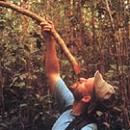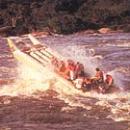ORINOCO: Rapids and Jungle
AYACUCHO PORT I arrived in Ayacucho Port after an 11-hour bus ride from Bolivar City. However, the trip was real fun as I kept on eyeing passengers getting on and off the bus, including scores of indigenous locals carrying their buying. At one of the bus stops, vendors were hawking casabe tortillas –made of cassava- and naivoa, a delicious pastry sweet made of sugar, cinnamon and cheese rolled up in casabe.
Finally, we made it to Ayacucho Port, a city founded in 1924 as the gateway to the Amazonas. Mario Vogt, my tropic-rooted German guide, was right there waiting for me. He showed me many of the zone's secrets and the lifestyle of its dwellers. Having a good guide in the jungle is key and Mario couldn't be any better. Good guides, though, count on the indispensable help provided by indigenous guides, the only ones who can really traipse into that jungle-like maze.
Ayacucho Port has no great charms. One of its few must-sees is Indians Square, the name by which everybody knows the Romulo Betancourt Plaza next to the Cathedral, the spot where indigenous peddlers huddle every day to sell their handicrafts.
At the fish market, fresh or smoked seafood is on sale. The size of part of the catch is really something. There are other curious goods like, say, a kind of ant dubbed “fat-bottomed bachaco” which is eaten alive.
Another visit you can't pass up is climbing the Zamuro Watchtower to steal a bird's eye view at the Atures Rapids that during the rainy season –extending from May to November- become the world's widest.
EL TUPARRO NATIONAL PARK Camps are by and large the primary lodging choice. I accommodate myself at the Orinoquia Camp cacaotravel@cantv.net lying in a fascinating place by the Orinoco River just a 20-minute drive from Ayacucho Port. The camp is owned by the Cacao Travel Group company www.cacaotravel.com
My first grand tour takes me to El Tuparro National Park in Colombia. To get there, we are ferried on a barge down the swollen river –12 meters higher than in the drought season. The watercourse might likely be a couple of kilometers wide over here.
In the underwater realm, water and vegetation pit against each other in a restless battle, inching in and scuttling with the coming of every seasonal flooding.
Orchid flowers remain remarkably well preserved both in color and texture for three months, a quality that turned them into coveted commodities for merchants. We carry on to the mystical Maipures Rapids. The river gets rough for six long kilometers –jet streams, eddies, treacherous pebbles that make sailing an impossible experience. German sage Humboldt called these the world's eighth wonder.
On the right bank –in Colombian territory- we walk deep into the flooded jungle. My bargee's name is Jose Hidalgo Rodriguez, a Guajibo Indian with a special flair to get his bearings in the middle of those vegetation-woven labyrinths. We reach Caño Lapa with a feeling of stepping into a lost world. The Caño Lapa's torrent is absolutely crystal-clear due to the lack suspended materials. Rocky formations are so old and hard that rivers and watercourses turn them into powder-thin particles very slowly.
We head back before the night closes in. We sail on faster now pushed by the current. There's time to barge into Tomo River –one of the Orinoco's 200 tributaries- down to a spot where river dolphins or toninas –as they are called in this neck of the woods- swim around.
THE HIKES There are hikes for everyone ranging from the toughest to simple strolls. Guides warn about each and every one of them.
Trailing behind a Curripako Indian named Jaime Rojas, we tag along on a six-hour hike to the Paria Waterfalls. We first walk past a village of piaroas –members of an ethnic group that vastly populates this area and whose cone-shaped huts strike my attention. There are some plantations in lands hacked away from the jungle by the Indians, yet the soil is shear sand. The jungle here has remained unaltered for millions of years. As I walk deep into the heart of the jungle, I've got a feeling of living both the present and the past in the same breath.
The indigenous guide belongs to an ethnic group that excels in wild plants. Blandishing his machete, he cuts a nock in a trunk that spurts out a white juice that turns chewy in the mouth. Another plant is used to soothe toothaches. I chew it for a short while and a sensation of local anesthesia kicks in. The trail is blocked only by gigantic fallen trees that lay bare a few hollow roots. Lianas twist like splicing wires around straight-up trunks. Scarce shrubs crawl down the ground because only feeble rays of light manage to trickle through.
A while later, I meet a bunch of northern Spaniards. We hike together with Piaroa guide Vidente Gonzalez in tow. We still had some spare time, so we made a short call to the Jungle Toboggan –its name stems from a huge slab in which a spring of crystal-clear waters slithers 20 meters down a 45-degree-angle slope into a natural pool.
RAFTING During the rainy season, the Atures Rapids are heftier and faster only to become the world's widest torrents since the Orinoco is the third most plentiful river under the sun featuring 200 tributaries and 600 sub-tributaries. In so special a place on the face of the earth, Jorge Buzzo has thought up a rafting course like no other. Moreover, he has put it within reach for anybody. As I watched from the shore those engulfing 3-meter-high waves, those whirlpools and the resulting foam, I got goose bumps thinking I was just about to raft down that current. But fear depends on habits and that fear vanishes as Jorge grabs the rudder and leads you through the most exciting nooks fully in control. The 12-year-old company is called Aguas Bravas (www.aguasbravas.net) and it has never had a fatal accident since then. They have built a raft equipped with a souped-up engine to rein in a mighty river like this and get kicks out of two hours and 17 kilometers of monstrous rapids.
To tell you the truth, fifteen passengers got on board with pale faces and got off later teeming with happiness. We really enjoyed and felt the Orinoco.
















































































